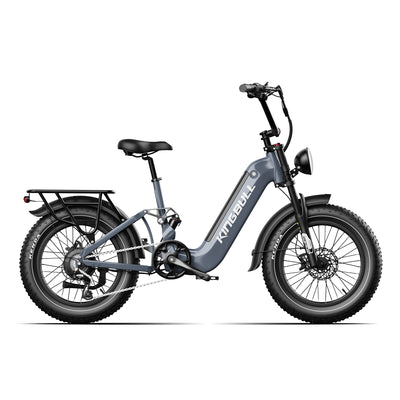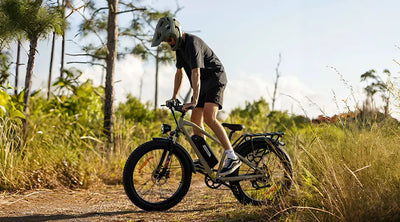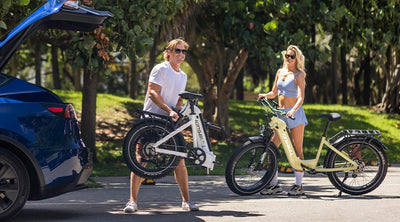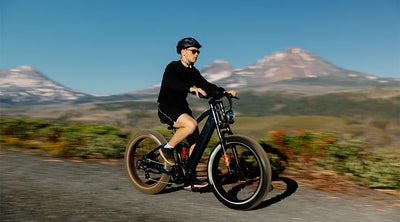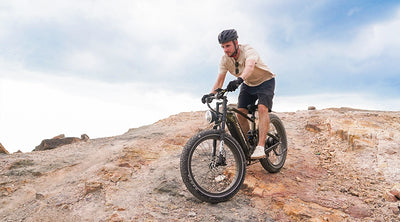Explore News

Kingbull NewsPurchase Guide
Empowering Women: Celebrating International Women's Day with Kingbull Electric Bikes
Happy International Women's Day to all the incredible women and mothers across various industries! Today, we celebrate the strength, resilience, and achievements of women around the world. International Women's Day is a moment to honor the contributions of women in every sector of society, from politics and science to business and the arts. It's a day to reflect on the progress we've made towards gender equality and to recognize the ongoing work that lies ahead. Here's to the women who inspire us, empower us, and shape the world around us. Happy Women's Day!
Origin of International Women's Day
International Women's Day originated from the late 19th and early 20th-century women's rights movements. The holiday was initially created to commemorate the struggles and labor rights of working-class women. On March 8, 1908, women workers in New York City held a massive protest demanding better working conditions and voting rights. This event later became the origin of International Women's Day and was first celebrated in countries like Denmark, Germany, Austria, and Switzerland in 1911. Today, it is observed by numerous countries worldwide, symbolizing the global recognition of women's rights and achievements.
Why We Celebrate Women's Day on March 8
Celebrating International Women's Day is not only to commemorate the past struggles and achievements of women but also to emphasize the importance of women's rights and equality in modern society. In today's world, women play indispensable roles in politics, economics, technology, and various social fields. Celebrating International Women's Day is a recognition of these efforts and achievements, as well as a call for continued efforts to advance women's rights.
How to Celebrate International Women's Day
International Women's Day is a moment filled with love and respect, and we can express our gratitude and care in various ways. In addition to sending a bouquet of flowers, a greeting card, or a small gift to express blessings and thanks to special women, we can celebrate this special day in more ways.
Firstly, we can choose to personally prepare a delicious breakfast or dinner for female family members or friends to express our love and gratitude. A carefully prepared breakfast or dinner is not only a gesture of care and appreciation, but also a way to repay them for their hard work and dedication. Additionally, we can participate together in the cooking process, share the joy of food, and deepen our emotional connection.
Secondly, we can organize an outdoor activity such as cycling and picnicking, to enjoy the beauty of nature and relax with female friends or family members. In the embrace of nature, we can communicate with each other, share our stories and dreams, and deepen our understanding and emotional bonds. Such activities not only promote friendship but also help us to relax and unwind, allowing us to escape from the busy life and enjoy moments of peace and joy together.
Finally, if you're looking to give a special woman a truly unique gift, then a Kingbull electric bike like the compact and foldable Literider could be the perfect choice. (Click here to learn about the benefits of ebikes.) This electric bike not only boasts a stylish and compact design that's easy to carry, but also offers outstanding performance and quality, allowing her to enjoy convenience and joy while riding. Giving her an electric bike is not just about showing care for her healthy lifestyle, but also about celebrating her unique taste and personality.
Conclusion
On International Women's Day, let us extend our warmest wishes and gratitude to all women, making them feel their value and importance. May we work together to create a fairer, more equal, and inclusive society. May all women and mothers continue to shine brightly in the days ahead, becoming leaders and role models in society. Wishing everyone a happy holiday!
Read more
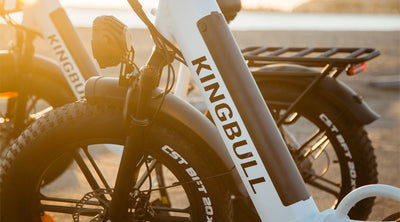
Kingbull News
Exploring Nature's New Choice: Fat Tire Electric Bikes
As you ride along the picturesque countryside paths, a fat tire electric bike might just become your ultimate companion. These unique bicycles come equipped with oversized fat tires, providing unparalleled stability and traction, allowing you to effortlessly tackle various terrains and road conditions. With fat tire electric bikes gaining popularity in the market, they have become the preferred choice not only for outdoor adventure enthusiasts but also for urban commuters and leisure riders. In this article, we will delve into the features and advantages of fat tire electric bikes, as well as the unique experiences they offer riders.
What Is a Fat Tire Electric Bike
Fat tire bikes are a special type of bicycle with wider tires compared to traditional bikes. These tires typically have widths ranging from 4 inches to 5 inches or even wider, much larger than the size of regular bike tires. The design of fat tires aims to provide a larger contact area and better traction, enabling them to easily handle various terrains and road conditions.
Originally designed for riding in specific terrains such as beaches, muddy trails, and snowy areas, fat tire bikes offer better flotation and stability in challenging conditions due to their wide tires.
Apart from riding in specialized terrains, fat tire bikes are also gaining popularity for urban and rural riding. Their unique appearance and robust performance attract the attention of many riders. Additionally, fat tire bikes are considered a comfortable riding option as their wide tires provide better shock absorption, resulting in a smoother and more comfortable ride.
The Advantages of Fat Tire Electric Bikes
Fat tire electric bikes have many advantages, making them a popular choice for riders. From providing a larger contact patch and better traction to enhancing stability and comfort, as well as adapting to various road conditions and environments, fat tire electric bikes offer riders a unique riding experience.
Stability and Traction
Fat tire electric bikes are equipped with oversized tires, providing a larger contact patch and better traction. This enhances stability, allowing riders to maintain balance even on challenging terrain and in varying weather conditions. With improved traction, the risk of slipping or sliding is significantly reduced, ensuring a safer and more secure riding experience. Additionally, the wider tires distribute the rider's weight more evenly, further enhancing stability and control, particularly when navigating through uneven surfaces or obstacles. Overall, the combination of a wide tire footprint and enhanced traction makes fat tire electric bikes exceptionally stable and reliable, offering riders confidence and peace of mind during their adventures.
Versatility
Due to their wide tire design, fat tire electric bikes are suitable for various terrains and road conditions, including beaches, muddy trails, snowy areas, and mountainous terrain. Riders can freely explore different environments without worrying about tire slippage or loss of traction. This versatility allows riders to confidently navigate through diverse landscapes and enjoy their adventures to the fullest.
Are Fat Tire Ebikes Harder to Pedal
Fat tire ebikes can be perceived as slightly harder to pedal than traditional ebikes with narrower tires, especially when riding on smooth surfaces or at higher speeds. The wider tires of fat tire ebikes create more rolling resistance, which means riders may need to exert slightly more effort to maintain speed. However, this increased resistance is often minimal and may not be noticeable to some riders, particularly when riding at lower speeds or on rough terrain where the wider tires provide better traction and stability. The electric assist motor on ebikes helps mitigate this additional resistance, making pedaling easier overall.
One factor to consider is that fat tire ebikes excel in challenging terrains such as sand, snow, or mud, where the wider tires provide better traction and stability. In such conditions, the electric motor assistance compensates for the increased rolling resistance, making it easier for riders to navigate through these environments with less effort.
Additionally, some riders appreciate the added workout that comes with pedaling a fat tire ebike, as it can provide a more engaging and physically demanding riding experience.
Ultimately, while fat tire ebikes may require slightly more effort to pedal in certain situations, the electric motor assistance ensures a comfortable and enjoyable riding experience overall, especially when tackling challenging terrains where fat tires shine.
What Are The Best Fat Tire Ebikes
Looking for the ultimate adventure companion that can conquer any terrain with ease? Look no further than fat tire ebikes. With their robust construction, oversized tires, and powerful electric motors, fat tire ebikes are designed to tackle the toughest trails, from sandy beaches to snowy mountains. But with so many options on the market, you might be wondering: what are the best fat tire ebikes out there?
Kingbull Literider
The ultimate combination of power, convenience, and versatility in the world of fat tire ebikes. Our folding fat tire electric bike is designed to provide unmatched performance and portability, making it the perfect choice for riders seeking adventure on any terrain.
Equipped with a powerful 1300W peak power motor (sustained 750W), the Kingbull Literider effortlessly conquers hills, trails, and urban streets alike. With its 48V lithium-ion battery boasting a capacity of 15Ah, you can enjoy extended rides with a range of up to 50 miles on a single charge.
But what truly sets the Kingbull Literider apart is its innovative folding design. With just a few simple steps, this bike folds down to a compact size, allowing you to easily transport it in your car trunk or store it in tight spaces. Whether you're commuting to work, exploring off-road trails, or embarking on a weekend adventure, the Kingbull Literider is ready to accompany you every step of the way.
With its 20*4" fat tires providing exceptional traction and stability, a top speed of 28 MPH, and a host of premium features, such as LED headlights and a durable aluminum alloy frame, the Kingbull Literider delivers an unparalleled riding experience.
So if you're in the market for a fat tire ebike, look no further than the Kingbull Literider. With its combination of performance, portability, and convenience, folding has never been a more compelling option. Experience the freedom to explore, anytime, anywhere, with the Kingbull Literider by your side.
Kingbull Voyager
Looking for a fat tire electric bike that can handle heavy loads and long distances with ease? Look no further than the Kingbull Cargo ebike-Voyager. Designed with practicality and performance in mind, the Kingbull Voyager is the ultimate solution for those who need to transport goods or equipment while enjoying the benefits of electric biking.
With a range of up to 60 miles on a single charge, the Kingbull Voyager Cargo ensures that you can go the distance without worrying about running out of power. Equipped with CST tires measuring 20"X4.0", the same as the Literider model, this bike provides excellent traction and stability on a variety of terrains, from city streets to rugged trails.
One of the standout features of the Kingbull Voyager is its impressive payload capacity of 440lb, allowing you to carry heavy loads with ease. Whether you're transporting groceries, camping gear, or work equipment, this bike can handle it all. Plus, with a top speed of 28 MPH and a powerful 1300W peak motor (750W sustained), you can cruise effortlessly through city traffic or tackle steep hills without breaking a sweat.
The Kingbull Voyager also features an elevated rear seat design, making it less prone to tipping over when carrying heavy loads. This added safety feature ensures a stable and secure ride, even when navigating tight corners or uneven terrain.
If you're in the market for a fat tire electric bike that's built for hauling cargo, the Kingbull Voyager is an excellent choice. With its impressive range, payload capacity, and top-notch performance, this bike is sure to meet all your transportation needs while delivering an exhilarating riding experience.
Conclusion
As we conclude our exploration of fat tire electric bikes, it's clear that they have revolutionized the way we approach cycling. With their ability to effortlessly conquer challenging terrains and provide a smooth, comfortable ride, fat tire electric bikes have captured the hearts of riders worldwide. Whether you're a seasoned outdoor enthusiast or a casual rider looking for a new way to explore, investing in a fat tire electric bike opens up a world of possibilities for adventure and excitement. So, saddle up, embrace the journey, and let the thrill of riding a fat tire electric bike take you to places you've never imagined.
Read more

Kingbull News
Exploring the Benefits: The Advantages of Riding an Electric Bike
In modern life, with the increasing awareness of environmental protection and the pursuit of a healthy lifestyle, electric bikes have gradually become a part of people's lives as an eco-friendly and convenient means of transportation. Riding an electric bike is not only a simple way to get around, but also a healthy and environmentally friendly lifestyle choice. In this article, we will explore the many benefits of riding an electric bike and how they can transform our lives.
Health Benefits
One of the most significant advantages of riding an electric bike is the improvement it brings to our physical well-being. Unlike traditional bicycles, electric bikes provide assistance when pedaling, making cycling less strenuous and more accessible to individuals of all fitness levels. Regular cycling can help strengthen muscles, improve cardiovascular health, and boost overall fitness. Moreover, commuting by electric bike allows individuals to incorporate physical activity into their daily routines, promoting a more active and healthier lifestyle.
Environmental Benefits
Electric bikes are a greener alternative to conventional vehicles, emitting zero carbon emissions and reducing air pollution. By opting for electric bikes instead of cars or motorcycles, individuals can significantly reduce their carbon footprint and contribute to mitigating climate change. Additionally, electric bikes require less energy to operate compared to motor vehicles, making them a more sustainable mode of transportation.
Cost Savings
In addition to the health and environmental benefits, riding an electric bike can also lead to substantial cost savings. Electric bikes are more affordable to purchase and maintain than cars or motorcycles, with lower fuel and maintenance costs. Furthermore, commuting by electric bike eliminates the need for parking fees, tolls, and other expenses associated with owning a vehicle. Over time, the savings accrued from using an electric bike can be substantial, making it a cost-effective transportation solution.
Convenience and Accessibility
Electric bikes offer unparalleled convenience and accessibility, allowing individuals to navigate through traffic congestion and reach their destinations more quickly. With electric assistance, riders can tackle hills and long distances with ease, expanding their commuting range and reducing travel time. Electric bikes are also suitable for individuals of all ages and fitness levels, providing an inclusive transportation option for a wide range of people.
Expanding Social Circle
Cycling is not only a healthy form of exercise but also an excellent way to expand your social circle. When you ride, you'll find yourself closer to the surrounding environment, with more opportunities to interact with passersby. Whether on dedicated bike lanes or in parks, you'll encounter other cyclists and pedestrians, who may come from different backgrounds, ages, and professions. However, the shared passion for cycling quickly fosters connections among you.
During your rides, you can also participate in group cycling events or community rides. These activities typically bring together individuals from various fields, providing you with excellent opportunities to meet new friends. Through shared interests and goals, your relationships with others will gradually deepen, thereby expanding your social circle.
Discovering Hidden Gems
Riding an electric bike is not just a means of transportation, but also an opportunity to explore the world. It can take you to more places and unveil many scenic views you may have overlooked before. When you start riding, you'll notice paths along the roadside, suburban parks, lakes, and forests, which may have been unnoticed corners in your daily life. The flexibility and convenience of electric bikes enable you to explore farther, beyond the hustle and bustle of the city, and into the embrace of nature. During these explorations, you may discover hidden treasures such as beautiful landmarks, captivating scenery, and marvelous experiences immersed in nature. Therefore, cycling is not only a way to exercise but also a journey of discovering the world and exploring the unknown, enriching our lives in countless ways.
Release Stress
Cycling is not just a physical activity; it's also an effective way to release stress and promote mental well-being. In modern life, people often face various sources of pressure, such as work stress, relationship issues, financial pressures, and more. Cycling, on the other hand, is a pleasurable activity that allows individuals to momentarily escape the hustle and bustle of city life and unwind amidst the picturesque natural scenery.
During cycling, the physical activity triggers the release of neurotransmitters such as dopamine and endorphins. These chemicals promote feelings of pleasure and happiness, aiding in the alleviation of anxiety and depression. Additionally, cycling is an aerobic exercise that enhances cardiovascular function, improves endurance, and boosts resilience against stress. Through prolonged aerobic workouts, individuals can release pent-up negative emotions, achieving a state of relaxation and stress reduction.
Exercise
Riding an electric bike provides an ideal solution for those who need appropriate exercise but cannot engage in high-intensity workouts. For some individuals, high-intensity exercise may present challenges or even risks due to factors such as age, health conditions, or other limitations. However, riding an electric bike offers a low-pressure, low-risk exercise option.
The pedal-assist feature of electric bikes makes cycling easier, allowing riders to navigate through undulating terrain or cover long distances with ease. This means that even those lacking exercise experience or experiencing physical discomfort can easily ride an electric bike and enjoy the benefits of outdoor activity.
Through riding an electric bike, these individuals can gradually increase their level of physical activity, improving cardiovascular health, enhancing muscle strength, and boosting overall fitness levels without undue pressure or risk. Electric bike riding not only provides a beneficial form of physical activity but also offers a safe, comfortable option for those in need of progressive exercise, helping them to maintain health and vitality.
Effortless Storage and Transport
The convenience of electric bikes lies in their portability. Many electric bikes are designed to be foldable or collapsible, making them extremely convenient for storage and transportation. Whether you need to store them in a small space at home or take them on a trip, they require minimal storage space.
These foldable electric bikes can quickly fold into smaller sizes to fit into various storage locations, such as apartment closets, office corners, or narrow spaces in the garage. Moreover, their lightweight design makes them easy to carry and store, even for those with limited strength.
What's even more remarkable is that even for long-distance travel, you can easily fit a foldable electric bike into the trunk of your vehicle. This means you can enjoy riding anytime, anywhere during your journey without the need for additional arrangements or transportation tools.
Accessibility and Adaptability
Riding an electric bike is easier to pick up compared to a traditional bicycle, requiring less skill and physical effort. The electric assistance system provides additional power support during the ride, enabling riders to easily adapt to various road conditions and cycling scenarios. Additionally, electric bikes are typically equipped with multiple riding modes and speed settings, which can be adjusted according to individual preferences and needs. This makes electric bikes more flexible and adaptable, catering to the requirements and riding styles of different cyclists. Therefore, whether you are a beginner or someone who doesn't cycle regularly, you can quickly get the hang of riding an electric bike and enjoy a relaxed and convenient cycling experience.
Conclusion
Riding an electric bike brings numerous benefits, improving not only our health but also contributing to environmental conservation efforts. By choosing electric bikes as our mode of transportation, we can enjoy a healthier and more convenient lifestyle while actively participating in environmental initiatives. Therefore, let us encourage more people to join the ranks of electric bike riders and work together to contribute to building a better future.
Read more

Purchase Guide
Valentine's Day Gift Ideas for Him/Her from Kingbull Electric Bikes
As Valentine's Day approaches, the choice of gifts between men and women is always filled with differences and challenges. Perhaps, a guy might think that gifting a PS5 is the perfect expression of love, while his partner may be eagerly anticipating a set of coveted cosmetics. This contrast isn't merely about differing material desires but delves deeper into understanding each other's needs and interests. Therefore, selecting a gift that satisfies both parties is far from a simple task. In this article, Kingbull will guide you through what you can gift to your significant other on Valentine's Day.
Why Choose Kingbull Electric Bikes as Gifts
When choosing a Valentine's Day gift, the Kingbull electric bicycle is an ideal option, and here's why. Firstly, practicality is key. This electric bicycle is not only a convenient mode of transportation but also a necessity in modern life. By choosing to gift your significant other with this bike, you are providing them with a convenient means of travel, allowing them to complete daily commutes more quickly and easily, thus saving precious time.
Secondly, the Kingbull electric bicycle is not only practical but also boasts a stylish and attractive design. As a modern technological product, it not only offers powerful functionality but also exudes a fashionable appearance. This can enhance your partner's image, allowing them to emit confidence and style while riding.
Additionally, this electric bicycle is environmentally friendly and energy-efficient. Compared to traditional cars or motorcycles, electric bicycles are more environmentally friendly, reducing pollution and making a positive contribution to protecting the planet. Therefore, choosing the Kingbull electric bicycle as a Valentine's Day gift not only meets your partner's travel needs but also promotes cost-saving and low-carbon living.
Finally, Kingbull electric bikes also come with excellent quality and performance assurance. Therefore, selecting it as a Valentine's Day gift not only provides your partner with greater convenience and comfort in daily life but also showcases your thoughtfulness and care.
The Recommended Electric Bike for Her/Him
When selecting an electric bicycle as a gift, considering the recipient is a woman, both the Voyager and Literider are excellent choices. They both feature a step-through design, providing many practical benefits for female riders.
Firstly, the step-through design makes getting on and off the bike easier and more comfortable. Compared to traditional top-tube designs, step-through frames are lower, eliminating the need for women riders to awkwardly straddle a high top tube. This is especially convenient for those wearing skirts or with limited flexibility.
Secondly, this type of bike offers a more stable and secure riding experience. With a lower center of gravity, step-through frames provide enhanced stability during rides, which is an important consideration for many female riders. Whether navigating city streets or riding on rural paths, this stability provides riders with increased confidence and comfort.
Lastly, these bikes are typically designed to be lightweight, making them easier to maneuver. For female riders, lightweight electric bicycles are not only easier to push and handle but also more convenient to lift or carry when necessary. If you're considering gifting her a foldable electric bike, you can opt for the Literider, which folds quickly and easily with just a few simple steps.
When considering gifting an electric bike to a male, the Rover could be an excellent choice. This electric bike features a soft tail design, meaning it can provide a more comfortable riding experience, especially on uneven surfaces. The soft tail design also helps to reduce bumps and vibrations, making the ride smoother and more enjoyable. Additionally, the equipped suspension system further enhances riding comfort, allowing the rider to enjoy a smooth experience across various road conditions.
The Rover boasts a powerful propulsion system, capable of effortlessly handling various terrains, including rugged mountain paths, beaches, and muddy trails. This means your friend or family member can navigate through diverse environments with ease, enjoying greater freedom and fun.
Model
Rover
Literider
Voyager
Style
Step-Over
Step-Through
Step-Through
Motor
750W
750W
750W
Battery
17.5Ah
15Ah
17.5Ah
Range
60 Miles
50 Miles
60 Miles
Top Speed
28 MPH
28 MPH
28 MPH
Frame
6061 Aluminum Alloy with Internal Battery
6061 Aluminum Alloy with Internal Battery
6061 Aluminum Alloy with Internal Battery
Tires
26"X4.0"
20"X4.0"
20"X4.0"
Payload Capacity
440lbs
400 lbs
440lbs
Price
$1299
$1199
$1399
Conclusion
In this romantic season, presenting a carefully chosen gift is not only a way to express love but also a gesture of respect and care for each other's relationship. Whether it's a thoughtful little gift or a grand surprise, the key lies in sincerity. Choosing a unique and practical gift from Kingbull Electric Bikes will bring endless surprises and joy to your loved one. Whether roaming the city streets or adventuring in the countryside, a Kingbull electric bike can be the perfect companion for you and your partner to share beautiful moments together. Let's create wonderful memories and cherish unforgettable moments this Valentine's Day with a Kingbull electric bike.
Read more
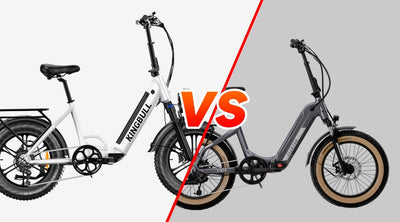
Ebike ComparisonPurchase Guide
Balancing Portability and Performance: Comprehensive Comparison of Folding Electric Bikes
In recent years, with growing concerns about sustainable modes of transportation, folding electric bikes have become an increasingly favored choice. This stylish and portable means of commuting not only meets the convenience demands of urban life but also aligns with the eco-friendly ethos of modern mobility. In this rapidly evolving market, Literider stands out with its outstanding performance and budget-friendly price, making it one of the preferred choices for numerous consumers seeking an ideal folding electric bike.
Performance Overview
Kingbull's Literider
Aventon's Sinch.2
Motor
1300W (peak), 750W (sustained), 48V
750w (peak), 500w (sustained), 48v
Battery
Removable lithium-ion 48V, 15Ah battery
48V, 14Ah (672Wh) LG Cell, UL 2849 Compliant
Speed
28 MPH
20 MPH
Range
Up to 50 miles
Up to 55 miles
Pedal Assist
5 level
4 Levels
Brakes
Hydraulic
Mechanical
Throttle
Half twist
Throttle on demand
Sensor
Cadence
Torque
Gears
7 Speed
8 Speed
Weight
73lbs
68 lbs
Payload Capacity
400 lbs
300 lbs
Frame
6061 AluminumAlloy With Internal Battery
Single-Butted Aluminum Alloy
Wheels
20" x 4.0"
20" x 4.0"
Light
Included
Included
Price
$999
$1,699
Next, we will delve into a detailed comparison of these data points to gain a comprehensive understanding of the performance, features, and advantages of each bicycle. Each data point will serve as the foundation for our in-depth analysis, aiding you in making a more informed decision. Let's explore together and find the electric bicycle that best suits your needs.
Motor & Battery
In terms of peak power, Literider's motor demonstrates a notably powerful performance, particularly evident in its 1300W peak power. Peak power represents the maximum power the motor can deliver in an extremely short duration. Compared to Sinch.2's 750W, Kingbull's 1300W peak power showcases higher performance potential.
The advantage of peak power is primarily manifested in providing robust acceleration performance. Increasing peak power can result in faster acceleration, enhancing the overall riding experience, especially during starts or uphill climbs. It's important to note that while peak power is a key indicator of motor performance, practical considerations in real-world riding, such as sustained power, voltage, and other factors, also need to be taken into account for a comprehensive evaluation of motor performance.
Literider's battery stands out with a significant advantage, boasting a high capacity of 15Ah. In comparison, Sinch.2's battery has a capacity of 14Ah. This implies that theoretically, Literider's battery can provide a longer riding range.
Furthermore, Sinch.2 utilizes batteries from the well-known brand LG, enhancing user trust to a certain extent. However, this may also result in a relatively higher product price. Despite Kingbull not opting for a prominent brand for its battery, we emphasize that it undergoes rigorous testing, ensuring reliable quality that users can trust.
Speed & Range
Literider's speed is significantly higher, reaching 28 MPH, whereas Sinch.2's speed is 20 MPH. It's important to note that, according to various state regulations, Sinch.2's speed of 20 MPH complies with the standards in most states. However, Literider's speed of 28 MPH not only complies with regulations but also provides greater speed flexibility for states with a 28 MPH limit.
This implies that Literider's design takes into account the legal differences among states, offering users a broader range of speed options. Therefore, regardless of the speed regulations in a user's state, Kingbull can meet compliant riding needs. Nevertheless, we emphasize prioritizing safety and encourage users to adhere to local regulations and practice safety measures while riding.
Brakes
The Literider is equipped with hydraulic brakes, whereas the Sinch.2 utilizes mechanical brakes. Hydraulic brake systems offer superior braking performance and ease of control, particularly in high-speed and emergency braking situations, allowing riders to have more precise command over braking force. On the other hand, mechanical brakes may be more suitable for general riding conditions, especially for electric bikes where extremely high braking performance is not always a primary requirement.
Sensor
The choice between Literider's Cadence sensor and Sinch.2's Torque sensor in terms of riding assistance depends on the rider's personal preference. The Cadence sensor on Literider perceives the rotation speed of the pedals, providing a relatively even assistance, resulting in a smoother riding experience. On the other hand, the Torque sensor on Sinch.2 detects the force applied by the rider to the pedals, offering a more dynamic and personalized assistance based on the rider's exerted force. Therefore, the selection between the two depends on whether the rider prefers a consistent and steady riding experience or a more dynamic and personalized assistance feel.
Weight & Payload Capacity
Literider and Sinch.2 differ in terms of weight and payload capacity. Literider has a higher overall weight at 73 lbs, while Sinch.2 is comparatively lighter at 68 lbs. However, in terms of payload capacity, Literider boasts a higher capacity, supporting loads of up to 400 lbs, whereas Sinch.2 has a payload capacity of 300 lbs. These differences may reflect variations in the construction and design of the two electric bikes, and users should consider their specific needs regarding bike usage and load requirements when making a choice.
Price
Comparing the prices, Literider is currently priced at $999, while Sinch.2 comes in at $1699. Despite Literider's strong performance, its price is quite reasonable. Not only does it deliver great performance, but it also won't break the bank. This makes Literider an electric bike with both impressive performance and an affordable price, making it especially suitable for those who want high performance without burning a hole in their pockets.
Conclusion
Taking into account factors such as price, performance, and practicality, Literider undoubtedly shines as a brilliant star in the folding electric bike market. Its robust performance coupled with an affordable price makes it the top choice for a growing number of individuals seeking a high-performance and cost-effective means of transportation. When it comes to selecting a folding electric bike, Literider's exceptional performance undeniably delivers an outstanding riding experience for cyclists.
Read more

Kingbull News
Kingbull Literider New Release: Stylish Folding Electric Bike Leading the Future of Commuting Trends
We are thrilled to announce the launch of our latest folding electric bike - the Literider. Following the success of Kingbull's previous releases, including the Cargo electric bike Voyager and the off-road electric bike Rover, the Literider represents our newest addition to the lineup. Its introduction signifies Kingbull's ongoing commitment to innovation in the electric bike industry, further expanding our product range to cater to a wider range of commuting needs.
Portable Design, Endless Possibilities
The design of the Literider aims to meet the diverse travel needs of modern urban life. Its carefully crafted folding function not only allows you to effortlessly fold the bicycle into a compact form when not in use but also ensures stability and reliability during folding. This convenient folding design means you can easily carry the Literider onto public transportation or store it in small spaces at home or in the office without worrying about taking up too much space. The folding frame, handlebars, and pedals of the Literider are ingeniously designed to ensure smooth folding and stable unfolding. Whether commuting on busy city streets or exploring the countryside, the Literider provides excellent portability and practicality, making your travels more enjoyable and hassle-free.
Superior Performance
The Literider is equipped with 20"X4.0"-inch wide tires suitable for various terrains, ensuring smooth navigation across different road surfaces. With adjustable handlebars, Shimano 7-speed gears, and 5-level pedal assistance, riders can customize their riding experience to suit their preferences. The hydraulic braking system ensures shorter braking distances, prioritizing rider safety at all times.
Featuring a sleek white design and integrated battery, the Literider boasts a minimalist yet eye-catching appearance. Its frame is constructed from upgraded 6061 aluminum alloy, ensuring durability and capable of supporting weights of up to 400 pounds while safeguarding the battery.
Powered by a 48V 15Ah lithium-ion battery and a 750W hub motor, the Literider delivers impressive performance. With a peak power of 1300W, it can achieve speeds of up to 28 miles per hour, while offering a maximum range of over 50 miles on a single charge. These performance features guarantee exciting and efficient outdoor adventures, making it convenient for riders to explore longer journeys with ease.
Technical Specifications
1300W (peak), 750W (sustained), 48V Motor
Half Twist Throttle
28 MPH
Removable lithium-ion 48V, 15Ah battery
5 level Pedal Assist
6061 AluminumAlloy With Internal Battery
20" x 4.0" CST All-terrain Tires
Shimano 7 speed
Hydraulic Brakes
Kingbull's Commitment
Kingbull is committed to providing high-quality, innovative electric transportation solutions for users worldwide. Through continuous innovation and technological upgrades, we are dedicated to advancing the development of electric mobility and delivering smarter, more convenient travel options for users.
Read more







